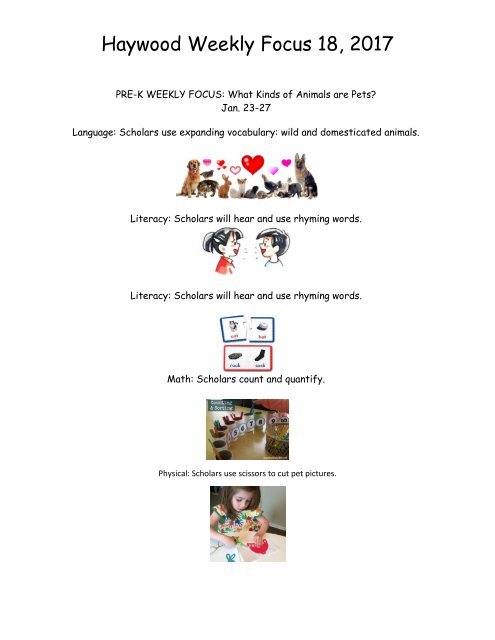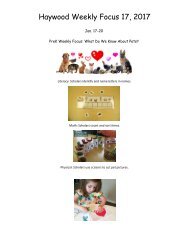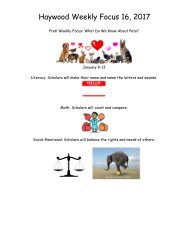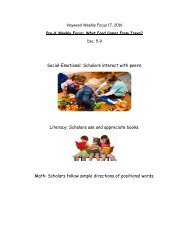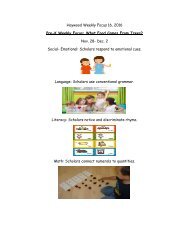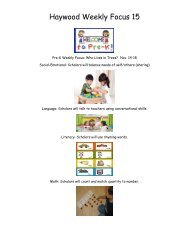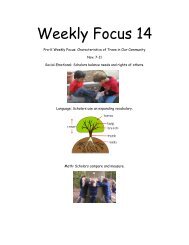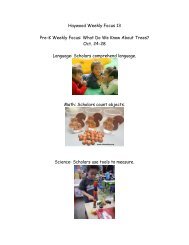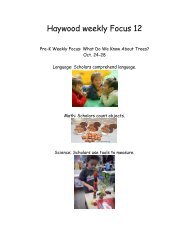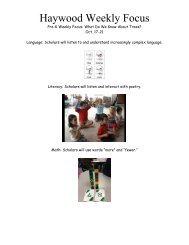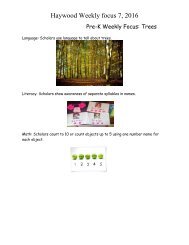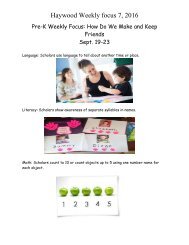Weekly Focus 18 2017
Create successful ePaper yourself
Turn your PDF publications into a flip-book with our unique Google optimized e-Paper software.
Haywood <strong>Weekly</strong> <strong>Focus</strong> <strong>18</strong>, <strong>2017</strong><br />
PRE-K WEEKLY FOCUS: What Kinds of Animals are Pets?<br />
Jan. 23-27<br />
Language: Scholars use expanding vocabulary: wild and domesticated animals.<br />
Literacy: Scholars will hear and use rhyming words.<br />
Literacy: Scholars will hear and use rhyming words.<br />
Math: Scholars count and quantify.<br />
Physical: Scholars use scissors to cut pet pictures.
Haywood <strong>Weekly</strong> <strong>Focus</strong> <strong>18</strong>, <strong>2017</strong><br />
Subject<br />
RLA<br />
Kindergarten <strong>Weekly</strong> <strong>Focus</strong> Week of January 23-27th<br />
Scholars will identify the reasons an author gives to support points in a text.<br />
Scholars will use drawings, dictation and writing to compose informative/explanatory text.<br />
RI.K8 With prompting and support, identify the reasons an author gives to support points<br />
in a text.<br />
W.K.2 Use a combination of drawing, dictating, and writing to compose<br />
informative/explanatory texts in which they name what they are writing about and<br />
supply some information about the topic.<br />
RF.K.4 Read emergent-reader texts with purpose and understanding. (Reinforce)
Haywood <strong>Weekly</strong> <strong>Focus</strong> <strong>18</strong>, <strong>2017</strong><br />
Math<br />
Scholars will be able to identify whether the number of objects in a group is greater than, less<br />
than, equal to another group of objets.<br />
K.CC.A.1 Count to 100 by ones and tens (Goal is up to 60 at this time).<br />
Youtube: https://youtu.be/estMnWVEjrk<br />
Social<br />
Studies<br />
Scholars will know that they interact with their environment through their senses.<br />
Science<br />
Scholars will recognize that things are living and some are not.
Haywood <strong>Weekly</strong> <strong>Focus</strong> <strong>18</strong>, <strong>2017</strong>
Haywood <strong>Weekly</strong> <strong>Focus</strong> <strong>18</strong>, <strong>2017</strong><br />
Language Arts:<br />
**Standard:<br />
RF.1.3c Know final _e and common long<br />
vowel team conventions for representing<br />
long vowel sounds.<br />
Objective:<br />
I can read and write long o words that<br />
have a silent e.<br />
Journeys Lesson 16:<br />
Informational Text: Let’s Go to the Moon!<br />
Genre: Informational<br />
Strategy: Question<br />
Skill: Main Idea/Details, Author’s Purpose<br />
**Standard:<br />
RI1.2 Identify the main topic and retell<br />
key details of a text.<br />
Objective:<br />
*I can identify the main idea and details<br />
about a topic.<br />
**Standard:<br />
RI1.1 Ask and answer questions about key<br />
details in a text.<br />
Objective:<br />
*I can ask questions while reading a<br />
selection and look for text evidence to<br />
answer them.<br />
**Standard:<br />
W 1.1 Write opinion pieces in which they<br />
introduce the topic or name the book they<br />
are writing about, state an opinion, supply<br />
a reason for the opinion, and provide<br />
some sense of closure.<br />
Objective:<br />
*I can write my opinion about a topic and<br />
give reasons for my opinion in complete<br />
sentences.<br />
Fluency: Stress Vocabulary: Suffixes –y, -ful<br />
Writing: Opinion<br />
Grammar: Questions<br />
High Frequency Words/Sight Words:<br />
around, bring, show, because,<br />
carry, think, before, light<br />
Word Study/Spelling Words:<br />
so, go, no, home, hole, rope,
Haywood <strong>Weekly</strong> <strong>Focus</strong> <strong>18</strong>, <strong>2017</strong><br />
joke, bone, stove, poke<br />
Mathematics:<br />
**Standard: 1.OA.C.6<br />
Add and subtract within 20, demonstrating fluency for addition and subtraction<br />
within 10. Use strategies such as counting on; making ten (e.g., 8 + 6 = 8 + 2 + 4<br />
= 10 + 4 = 14); decomposing a number leading to a ten (e.g., 13 − 4 = 13 − 3<br />
− 1 = 10 − 1 = 9); using the relationship between addition and subtraction<br />
(e.g., knowing that 8 + 4 = 12, one knows 12 − 8 = 4); and creating equivalent<br />
but easier or known sums (e.g., adding 6 + 7 by creating the known equivalent 6<br />
+ 6 + 1 = 12 + 1 = 13).<br />
Monday 1/23/17 Go Math 4.4<br />
Objective:<br />
*I can use “Make a 10” as a strategy to subtract.<br />
Tuesday 1/24/17 Go Math 4.5<br />
Objective:<br />
*I can subtract by breaking apart to make a ten.<br />
Wednesday 1/25/17 Go Math 5.2<br />
Objective:<br />
*I can record related facts within 20.<br />
Thursday 1/26/17 Go Math 5.3<br />
Objective:<br />
*I can identify related addition and subtraction<br />
facts within 20.<br />
Friday 1/27/17 Go Math 5.4<br />
Objective:<br />
*I can apply the inverse relationship of addition<br />
and subtraction.
Haywood <strong>Weekly</strong> <strong>Focus</strong> <strong>18</strong>, <strong>2017</strong><br />
Science:<br />
GLE 0107.9.3<br />
**Standard: Predict the changes<br />
that may occur when different<br />
materials are mixed.<br />
https://www.youtube.com/watch?v=p5qvi20J5IM<br />
https://www.youtube.com/watch?v=ei5kGOW1wT8<br />
Objective:<br />
*I can predict the changes that<br />
can occur when different<br />
materials are mixed.<br />
https://www.youtube.com/watch?v=nw8KaHglokQ
Haywood <strong>Weekly</strong> <strong>Focus</strong> <strong>18</strong>, <strong>2017</strong><br />
http://www.wikihow.com/Make-Silly-Putty
Haywood <strong>Weekly</strong> <strong>Focus</strong> <strong>18</strong>, <strong>2017</strong><br />
Social Studies:<br />
Unit 4: Our Country the United States<br />
**Standards:<br />
1.25 Identify the current city/county Mayor, Governor, and President,<br />
and explain their roles in government.<br />
1.26 Explain the importance of patriotic traditions, including the<br />
recitation of the Pledge of Allegiance, appropriate behavior during the<br />
playing of our National Anthem, and demonstrate appropriate flag<br />
etiquette.<br />
1.27 Explain that our state’s and country’s laws are based upon the<br />
Constitution.<br />
Standard<br />
1.28 Give examples of a rule and a law through the use of drawings,<br />
discussions, or writings.<br />
1.29 Describe the fundamental principles of American democracy,<br />
including respect for the rights, opinions and property of others, fair<br />
treatment for all, and respect for the rules by which they live.<br />
1.30 Summarize that voting is a way of making choices and decisions.<br />
1.31 With guidance and support from adults, use a variety of digital tools<br />
to produce and publish an informational text on the importance of the<br />
voting process using facts and provide a concluding statement.<br />
1.33 Sort rules and responsibilities that citizens follow that are specific to<br />
their state compared to national rules and responsibilities, including<br />
wearing a seat belt, wearing a bicycle helmet, texting while driving.<br />
Objectives:<br />
*I can identify the Pledge of Allegiance of the United States and<br />
singing of the National Anthem as a patriotic tradition and<br />
demonstrate appropriate behavior during the pledge by placing my<br />
right hand over my heart and standing and facing the flag while<br />
reciting/singing it.<br />
*I can identify the President of the United States by saying:<br />
President Donald Trump is the President of the United States and<br />
explain that:<br />
Based on voting, President Donald Trump was elected president<br />
and will uphold the laws of our United States that come from the<br />
United States Constitution.
Haywood <strong>Weekly</strong> <strong>Focus</strong> <strong>18</strong>, <strong>2017</strong><br />
1/23-1/27<br />
Phonics:<br />
Long e sound for y<br />
Topic Standards I Can…<br />
(changing y to i ) and adding ies<br />
RF.2.3a distinguish long and<br />
short vowels when reading onesyllable<br />
words.<br />
RF.2.3b know spelling-sound<br />
correspondences for vowel<br />
teams.<br />
RF.2.3c decode two-syllable<br />
words with long vowels.<br />
Strategies:<br />
Sight word review<br />
-Picture sorts<br />
-Making words<br />
-Sound boxes<br />
-Analogy chart<br />
-chunk big words<br />
-high frequency<br />
-Word cards<br />
-Decodable reader<br />
-Model fluency<br />
I can connect sounds to writing and<br />
dictate sentences.<br />
Vocabulary:<br />
I can use context clues to figure<br />
out the meaning of words.<br />
My sister likes to be a pretend<br />
princess.
Haywood <strong>Weekly</strong> <strong>Focus</strong> <strong>18</strong>, <strong>2017</strong><br />
Comprehension:<br />
Main Idea and Details<br />
Understanding Characters<br />
-Main Idea<br />
Alphabet soup<br />
-Vocabulary word cards<br />
-Reader’s Notebook vocab.<br />
Strategies<br />
-Read Alouds w/ teacher’s<br />
manual<br />
-Curious About Words<br />
(resource)<br />
-Use visuals<br />
-Use gestures<br />
-Comprehensible input<br />
-Use sentence frames<br />
-EL leveled readers<br />
-Video clip for Lesson <strong>18</strong><br />
-Decodable Reader<br />
RL2.4 Describe how words and<br />
phrases supply rhythm and<br />
meaning.<br />
I can use character traits to<br />
describe the characters in the<br />
story My Name is Gabriela.
Haywood <strong>Weekly</strong> <strong>Focus</strong> <strong>18</strong>, <strong>2017</strong><br />
Target Strategy: Analyze/Evaluate<br />
RI.2.6 Identify the main purpose<br />
of a text.<br />
RL.2.10 Read and comprehend<br />
literature.<br />
I can identify the main idea and<br />
supporting details of the story My<br />
Name is Gabriela.<br />
Grammar:<br />
The Verb be
Haywood <strong>Weekly</strong> <strong>Focus</strong> <strong>18</strong>, <strong>2017</strong><br />
L.2.1d<br />
Know some verbs are irregularly<br />
formed in the past tense.<br />
Use correct forms of be<br />
Verbs am, is, are -<br />
(happening now)<br />
Verbs was and were -<br />
(in the past)<br />
Writing:<br />
Narrative Writing<br />
Math: Shapes<br />
W.2.3 Write narratives in which<br />
they recount a well-elaborated<br />
event or short sequence of<br />
events, include details to<br />
describe actions, thoughts, and<br />
feelings, use temporal words to<br />
signal event order, and provide<br />
a sense of closure.<br />
W2.6 With guidance and<br />
support from adults, use a<br />
variety of digital tools to<br />
produce and publish writing,<br />
including in collaboration with<br />
peers.<br />
I can write a story and retell the<br />
events in the correct sequence.
Haywood <strong>Weekly</strong> <strong>Focus</strong> <strong>18</strong>, <strong>2017</strong><br />
Social Studies:<br />
Essential Question:<br />
How are the ideas and attitudes of<br />
people of the past similar and<br />
different from today?<br />
What are the contributions of the<br />
past, the present, and the future?<br />
Studies <strong>Weekly</strong> 23: Scientists,<br />
artists, and inventors.<br />
Week 3<br />
Studies <strong>Weekly</strong> 23: Scientists,<br />
artists, and inventors.<br />
2.32<br />
Participate in shared research using<br />
biographies to interpret the<br />
significance of contributions made<br />
by people of the United States,<br />
recounting or describing key ideas<br />
and details from the texts. Teachers<br />
may choose any biographies.<br />
I can read a biography and<br />
understand how a person<br />
has contributed to our<br />
heritage.<br />
I can research a Famous American in<br />
the United States and share their<br />
contributions with the class.
Haywood <strong>Weekly</strong> <strong>Focus</strong> <strong>18</strong>, <strong>2017</strong><br />
Websites<br />
www.kidinfo.com<br />
www.brainpopjr.com<br />
kids.usa.gov/socialsocialstudiesforkids<br />
.com<br />
www.pebblego.com<br />
Essential Question: Why are reading and writing<br />
important?
Haywood <strong>Weekly</strong> <strong>Focus</strong> <strong>18</strong>, <strong>2017</strong><br />
3 rd Grade <strong>Weekly</strong> <strong>Focus</strong> January 23-27, <strong>2017</strong><br />
Subject<br />
ELA<br />
<strong>Weekly</strong> Skills to Practice<br />
For the next 2 weeks, 3 rd grade ELA students will be focusing on SYNTHESIZING and then using<br />
that skill to help them better UNDERSTAND CHARACTERS. The students will practice this skill<br />
through a variety of Interactive Read Alouds.<br />
Comprehension Skill/Strategy: Synthesizing, Understanding Characters<br />
Grammar <strong>Focus</strong>: Identify and using possessive nouns
Haywood <strong>Weekly</strong> <strong>Focus</strong> <strong>18</strong>, <strong>2017</strong><br />
Standards: RL.3.3 Describe characters in a story (e.g., their traits, motivations, or feelings) and<br />
explain how their actions contribute to the sequence of<br />
L.3.2d Form and use possessives.<br />
Writing <strong>Focus</strong>:<br />
Standard: W.3.3-Write narratives to develop real or imagined experiences or events using<br />
effective technique, descriptive details, and clear event sequences.<br />
Additionally, students should be reading for 20 minutes each night. They should be recording what<br />
they are reading in their agenda nightly.
Haywood <strong>Weekly</strong> <strong>Focus</strong> <strong>18</strong>, <strong>2017</strong><br />
Additionally, students should be reading for 20<br />
minutes each night. They should be recording<br />
what they are reading in their agenda nightly.<br />
Social<br />
Studies<br />
Students will continue studying Europe. Student will be able to study historical events, political<br />
figures, and famous artists, writers, and inventors. Studies <strong>Weekly</strong> Weeks: 16 and 17<br />
Vocabulary <strong>Focus</strong>: (Social Studies)- Europe, culture, architecture, philosophy, Ukraine, Germany<br />
Standards: 3.40 Use timelines, primary sources, and historical passages to summarize the history<br />
of a region, including events, inventions/inventors, artists, writers, and political figures.
Haywood <strong>Weekly</strong> <strong>Focus</strong> <strong>18</strong>, <strong>2017</strong><br />
Science<br />
Students<br />
will be<br />
working on<br />
magnets<br />
January<br />
28,<strong>2017</strong><br />
And<br />
February 3,<br />
<strong>2017</strong>.<br />
Force and<br />
Motion are<br />
coming<br />
soon!<br />
Standard: GLE 0307.Inq.4 Identify and interpret simple patterns of evidence to communicate the<br />
findings of multiple investigations Students will continue learning about magnets and<br />
identify tools needed to investigate specific questions. Analyze and communicate findings<br />
from multiple investigations of similar phenomena to reach a conclusion.<br />
Essential Understanding:<br />
1. Recognize that magnets can move objects without touching them.<br />
2. Experiment with magnets to determine how distance affects magnetic attraction.<br />
3. Record the success of the magnetic force through different depths of paper.<br />
4. Opposites attract, like charges repeal<br />
Objective: I can explore how magnets attract objects made of certain materials, and tell the<br />
difference between permanent and temporary magnets.<br />
Vocabulary:<br />
Magnet<br />
Attract<br />
Repel<br />
North Pole<br />
South Pole<br />
Magnetic Poles<br />
Temporary Magnets<br />
Permanent Magnets<br />
Magnetism
Haywood <strong>Weekly</strong> <strong>Focus</strong> <strong>18</strong>, <strong>2017</strong><br />
Math<br />
Standards: 3.MD.B.4 Generate measurement data by measuring lengths using rulers marked with<br />
halves and fourths of an inch. Show the data by making a line plot, where the horizontal scale is<br />
marked off in appropriate units— whole numbers, halves, or quarters<br />
Objective: I can measure data using rulers marked with halves and fourths of an inch by making<br />
a line plot.<br />
Academic Vocabulary: length, halve inch, fourth inch, , line plot, measurement, quarters, data<br />
3 ½ inches<br />
Additionally: Students<br />
2222<br />
need to be practicing multiplication facts daily. They have been given<br />
multiplication cards for home practice. Ask your child what facts they are working on!<br />
Computer<br />
Resources<br />
BrainPop Jr.<br />
www.brainpopjr.com<br />
Username: eaglet<br />
Password: eaglet<br />
Flocabulary<br />
www.flocabulary.com<br />
Username: westmiddlestudent4<br />
Password: westmiddlestudent4<br />
IXL website<br />
Khan Academy website<br />
Learn Zillion website<br />
News You<br />
Can Use!<br />
Upcoming Dates to Remember:<br />
2/8 Progress reports will be issued<br />
<br />
<br />
2/20 Students do not report, PD day for teachers<br />
Haywood t-shirts are available for you to buy for $10 cash every Friday from 7:30 – 8:00 in the gym by the<br />
PTO!
4 th Grades <strong>Weekly</strong> <strong>Focus</strong> Jan. 23 th –Jan 27 th<br />
Unit 4: Harvesting Hope: The Story of Cesar Chavez:<br />
Haywood <strong>Weekly</strong> January 23-February <strong>Focus</strong> 3<strong>18</strong>, <strong>2017</strong><br />
Essential Question: How can the actions of one-person lead to change?<br />
<strong>Weekly</strong> <strong>Focus</strong><br />
I can identify how the actions of one person can affect history.<br />
Use text structures to enhance comprehension of non-fiction and fictional<br />
texts. Integrate information from two texts on the same topic and<br />
compare/contrast multiple texts on their approach to a similar topic.<br />
Use various sources to conduct short research projects. Sort information from<br />
notes into relevant categories to develop a research question or focus.<br />
http://www.readworks.org/lessons/grade4/harvesting-hope-story-cesarchavez/read-aloud-lesson<br />
Foundations<br />
Latin roots, suffixes,<br />
-ful, -less, -ness, -ment<br />
(problem/solution/cause/effect)<br />
Standards<br />
Comprehension Strategies/Skills<br />
Theme, Sequence of events<br />
Grammar and Writing<br />
Research Writing<br />
Pronouns and adverbs
Haywood <strong>Weekly</strong> <strong>Focus</strong> <strong>18</strong>, <strong>2017</strong><br />
Vocabulary: Idiom,<br />
Figurative language, ,<br />
cause and effect, problem<br />
and solution, actions and<br />
results<br />
CCSS.ELA-<br />
Literacy.RI.4.4<br />
Determine the meaning<br />
of general academic and<br />
domain-specific words<br />
or phrases in a text<br />
relevant to a grade 4<br />
topic or subject area.<br />
Supplemental Literature<br />
Amelia’s Road, Potato: A tale of the great depression, Tough<br />
Times<br />
Social Studies
Haywood <strong>Weekly</strong> <strong>Focus</strong> <strong>18</strong>, <strong>2017</strong><br />
Living Museum<br />
launch<br />
Creating a new<br />
government,<br />
people, events,<br />
constitution )<br />
http://www.readworks.org/passages/am<br />
erican-government-bill-rights-part-i<br />
Bill of Rights<br />
http://www.readworks.org/passages/am<br />
erican-government-bill-rights-part-i<br />
Bill of Rights<br />
http://www.readworks.org/passages/wh<br />
at-and-who-elections<br />
Elections<br />
http://www.readworks.org/passages/am<br />
erican-government-preamble-unitedstates-constitution<br />
Preamble<br />
http://www.readworks.org/passages/am<br />
erican-government-branchesgovernment-closer-look<br />
3 branches of government<br />
Math<br />
CCSS.ELA-Literacy.RI.4.3<br />
Explain events, procedures,<br />
ideas, or concepts in a<br />
historical, scientific, or<br />
technical text, including what<br />
happened and why, based on<br />
specific information in the text.<br />
CCSS.ELA-Literacy.RI.4.5<br />
Describe the overall structure<br />
(e.g., chronology, comparison,<br />
cause/effect, problem/solution)<br />
of events, ideas, concepts, or<br />
information in a text or part of a<br />
text.<br />
CCSS.ELA-Literacy.RI.4.6<br />
Compare and contrast a<br />
firsthand and secondhand<br />
account of the same event or<br />
topic; describe the differences<br />
in focus and the information<br />
provided.<br />
4.NF.3: Understand a fraction a/b with a > 1 as a sum of fractions 1/b.<br />
a. Understand addition and subtraction of fractions as joining and separating<br />
parts referring to the same whole.<br />
Decompose a fraction into a sum of fractions with the same denominator in more than one way, recording each<br />
decomposition by an equation. Justify decompositions, e.g., by using a visual fraction<br />
model.<br />
Examples: 3/8 = 1/8 + 1/8 + 1/8 ;
Haywood <strong>Weekly</strong> <strong>Focus</strong> <strong>18</strong>, <strong>2017</strong><br />
3/8 = 1/8 + 2/8 ; 2 1/8 = 1 + 1 + 1/8 = 8/8 + 8/8 + 1/8.<br />
c. Add and subtract mixed numbers with like denominators, e.g., by replacing each mixed number with an equivalent<br />
fraction, and/or by using properties of operations and the relationship between addition and subtraction.<br />
d. Solve word problems involving addition and subtraction of fractions referring to the same whole and having like<br />
denominators, e.g., by using visual fraction models and equations to represent the problem.<br />
Essential Questions:<br />
1. Why do we use numbers, what are their properties, and how does our number system<br />
function?<br />
2. Why do we use estimation and when is it appropriate?<br />
3. What makes a strategy effective and efficient and the solution reasonable?<br />
4. How do numbers relate and compare to one another?<br />
We want students to understand that all numbers have parts, values, uses, types, and we<br />
use operations and reasonableness to work with them.
Haywood <strong>Weekly</strong> <strong>Focus</strong> <strong>18</strong>, <strong>2017</strong><br />
Students will know...<br />
1. How to draw<br />
visual<br />
representation<br />
of fractions<br />
using a variety<br />
of methods<br />
using their<br />
knowledge of<br />
fractional parts.<br />
2. That the<br />
denominator<br />
tells how many<br />
parts in the<br />
whole.<br />
3. That the<br />
numerator tells<br />
how many parts<br />
are being<br />
used/taken.<br />
4. A unit fraction<br />
is defined as a<br />
fraction with a<br />
numerator of<br />
one.<br />
5. That Montana<br />
American<br />
Indians are an<br />
integral part of<br />
Montana’s<br />
culture.<br />
6. The symbols<br />
>,
Haywood <strong>Weekly</strong> <strong>Focus</strong> <strong>18</strong>, <strong>2017</strong>
Haywood <strong>Weekly</strong> <strong>Focus</strong> <strong>18</strong>, <strong>2017</strong>
Haywood <strong>Weekly</strong> <strong>Focus</strong> <strong>18</strong>, <strong>2017</strong><br />
Task examples<br />
Pillow Task<br />
It takes ¼ yard of yellow fabric, ¼ yard of blue fabric and ¼ yard of white fabric<br />
to make a pillow. Jenny is making 6 pillows. How many yards of each color fabric<br />
will she need to make the 6 pillows? How many yards of total fabric will she<br />
need? Draw a model, write an equation and explain your thinking?<br />
Fresh Bread Task<br />
1. Jasper baked 7 loaves of fresh bread. He wants to give ¼ of the loaves to his<br />
brother, ¼ to his sister, ¼ to his cousin and ¼ for himself. How much does each<br />
person get?<br />
2. His brother doesn’t like bread and does not want his share. This means that<br />
Jasper, his sister and his cousin can each have 1/3 of the loaves. How much does<br />
each person get?<br />
Science<br />
Unit
-<br />
Haywood <strong>Weekly</strong> <strong>Focus</strong> <strong>18</strong>, <strong>2017</strong><br />
Moon Phases Timeframe- 3 Weeks<br />
<strong>Focus</strong> Standard: SPI 0407.6.1 Organize the phases<br />
of the moon in the correct sequence.<br />
SPI 0407.6.2 Infer that the moon's phases are caused<br />
by the revolution of the moon and earth around the<br />
sun.<br />
Guiding Question: How does the movement of<br />
Earth, moon and sun effect patterns humans observe<br />
in their daily lives?<br />
Vocabulary: Lunar, Lunar Cycle, Rotations, Revolution, Axis,<br />
Illuminate, Solar and Lunar Eclipse, New Moon ,Waxing,<br />
Crescent, First Quarter, Waxing Gibbous, Full Moon, Waning<br />
Gibbous, Third/Last Quarter, Waning, Crescent<br />
GLE 0407.6.1 Analyze patterns, relative<br />
movements, and relationship among the sun,<br />
moon, and earth.<br />
• Create models to show the interaction of the sun, moon and earth1<br />
• Create models to explain the occurrence of day and night1,3<br />
• Create timelines to memorize length of moon and earth’s revolutions3<br />
• Watch videos to observe the interaction among the sun, moon, and earth3<br />
• Write an informative paragraph explaining the interactions of the sun, moon, and<br />
earth<br />
Check 0407.6.2Sequence the major phases of the moon during a lunar cycle.<br />
• Nightly watch of the phases/whole class record keeping or science notebook<br />
record keeping2
Haywood <strong>Weekly</strong> <strong>Focus</strong> <strong>18</strong>, <strong>2017</strong><br />
• Banana/Oreo moon phases creation1<br />
• Construct moon phases study cards with moon phase depiction (include a sun and<br />
earth for students to<br />
organize the phases with the sun and earth included)1<br />
• Position the moon phases index cards in a line or circle, move the sun and earth<br />
in various positions on<br />
students’ desks1<br />
• Use large poster of moon phases for whole class recall of the phases2<br />
• Teacher-made or student-made charts for student or partner fill in of each moon<br />
phases (these charts<br />
should include the sun and earth in different positions)<br />
• Depict in science notebooks the position of the sun, moon, and earth at each<br />
phase (fill the notebook<br />
with charts showing the moon phases)<br />
• YouTube: Moon phases rap<br />
• YouTube: Moon phases song<br />
Check 0407.6.1 Chart the movement of the sun, moon, and earth to develop an<br />
explanation for the phases of the moon and solar and lunar eclipses.<br />
• Lunar Eclipse story: The moon is being a loner<br />
• Solar Eclipse story: The moon is saying “SUP Sun”<br />
• Depict in science notebooks the position of the sun, moon, and earth during the<br />
lunar and solar eclipses2<br />
• In-class demonstration of the moon’s movement (Materials needed: small white<br />
ball, lamp, dark room)<br />
A student holds the lamp in a dark room, another student holds the small white<br />
ball, they both line up,<br />
the student holding the ball kneels and moves the ball in a circle around their head,<br />
seeing all the<br />
different phases, therefore inferring the phases are caused but the moon’s position<br />
or the moon’s<br />
movement around the earth1<br />
• Lab report/science notebook explaining the process and discoveries during the inclass<br />
demonstration<br />
Resources:<br />
Moon Phases Rap
Haywood <strong>Weekly</strong> <strong>Focus</strong> <strong>18</strong>, <strong>2017</strong><br />
Flocabulary-Moon Phases<br />
Moon Phases Song<br />
Oreo Activity<br />
Ideas for Teaching the Moon Phases


